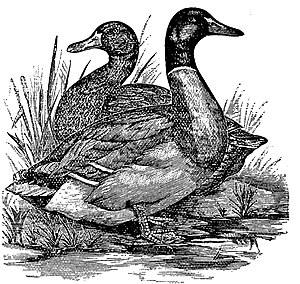
Ducks are a group of species of water birds – relatively small in size and with shorter necks than their close cousins of swans and geese. Along with their longer necked cousins, they make up the biological family of Anatidae. Humans have had a long relationship with members of this family by being economically and culturally important to us. Ducks, in particular, have been domesticated to be exploited for their feathers, eggs and meat.
Ducks have been domesticated as pets and farm animals for more than 500 years, and all domestic ducks are descended from either the mallard or the Muscovy duck. Mallards, especially, are easy to crossbreed with other types of ducks, and mallards often hybridise with all types of ducks at local ponds.
Ducks are used by Balinese farmers to seek and eat snails in their rice fields. This treats the snails as a food source, an input into duck farming, rather than an expensive problem to be treated with chemicals. It is a traditional agricultural technique which is consistent with permaculture.
Characteristics of Ducks
Ducks belong to the family Anatidae, which also includes swans and geese. They are generally smaller and have shorter necks than their relatives. Key characteristics of ducks include:
- Physical Features: Ducks have webbed feet, which make them excellent swimmers. Their bills are broad and flat, adapted for foraging in water.
- Plumage: Ducks exhibit a wide range of colors and patterns, often with iridescent feathers that are especially prominent in males.
- Lifespan and Size: Depending on the species, ducks can live between 5 to 10 years and vary significantly in size, with some species weighing just a few ounces while others can weigh up to 7 pounds.
Behavior and Diet
Ducks are omnivorous and have diverse diets that include aquatic plants, insects, small fish, and crustaceans. Their feeding behaviors are categorized into:
- Dabbling: Dabbling ducks feed on the surface of the water or tip their bodies forward to reach underwater plants.
- Diving: Diving ducks, as the name suggests, dive underwater to forage for food.
Ducks are social birds and often form flocks, especially during migration. They communicate through a variety of vocalizations, including quacks, whistles, and grunts.
Habitat and Distribution
Ducks are found on every continent except Antarctica. Their habitats range from freshwater lakes and rivers to coastal marshes and estuaries. Some common types of habitats include:
- Wetlands: Many ducks thrive in wetlands, which provide abundant food and nesting sites.
- Grasslands and Farmlands: These areas offer feeding grounds, especially for species that prefer seeds and grains.
- Urban Areas: Some ducks have adapted to living in urban parks and ponds, where they often interact with humans.
Importance of Ducks
Ducks play several critical roles in their ecosystems:
- Ecological Role: Ducks help maintain the health of aquatic ecosystems by controlling insect populations and spreading seeds.
- Cultural Significance: Ducks have been featured in art, literature, and folklore across various cultures. They are also important in hunting traditions and birdwatching activities.
- Economic Value: Ducks are farmed for their meat, eggs, and feathers. Duck farming is a significant industry in many parts of the world.
Conservation and Challenges
Many duck species face threats from habitat loss, pollution, and climate change. Conservation efforts focus on:
- Habitat Restoration: Protecting and restoring wetlands and other critical habitats is essential for duck conservation.
- Regulations and Hunting: Implementing and enforcing hunting regulations help ensure sustainable duck populations.
- Research and Monitoring: Ongoing research and monitoring programs track duck populations and health, providing data to inform conservation strategies.